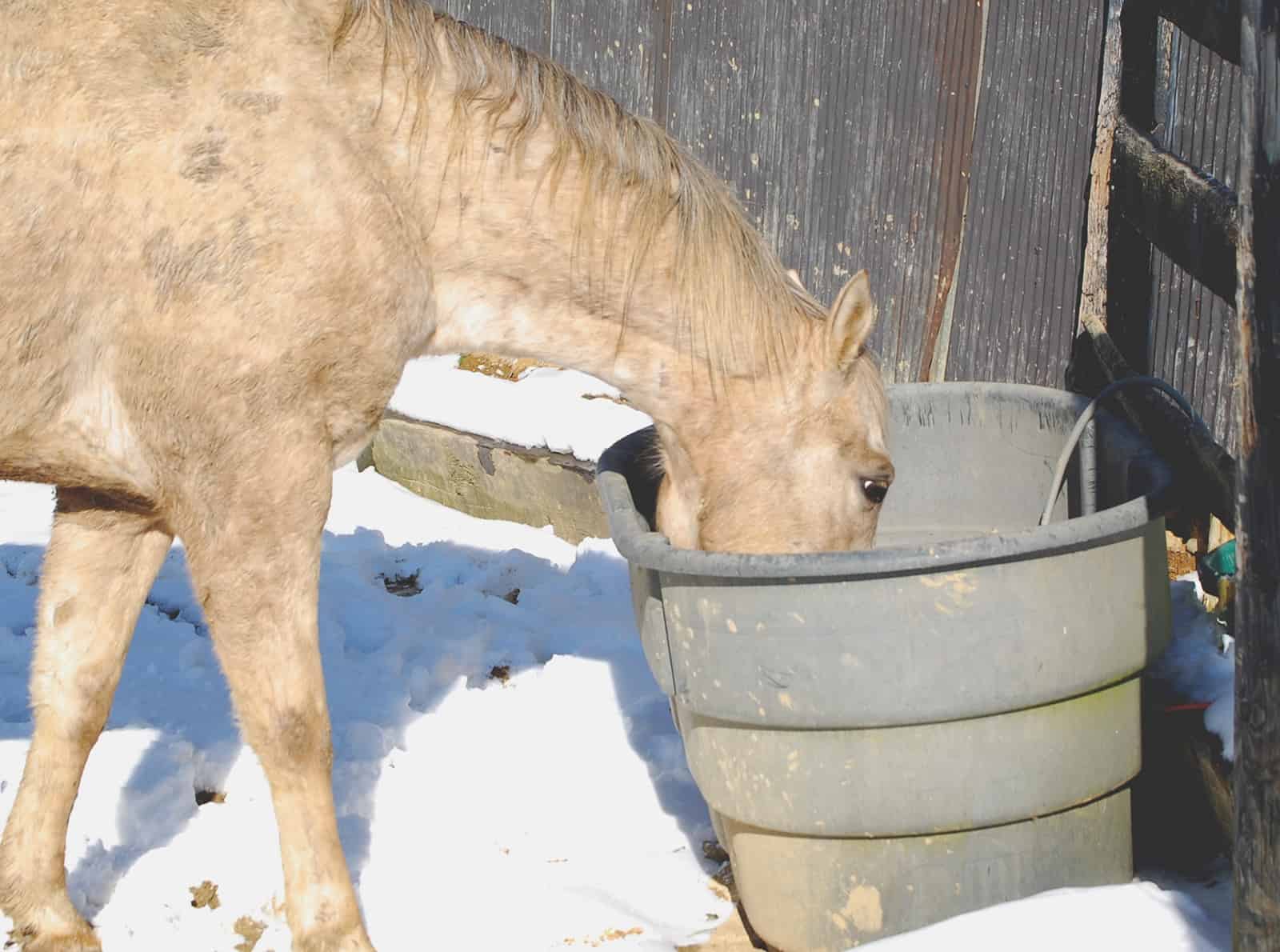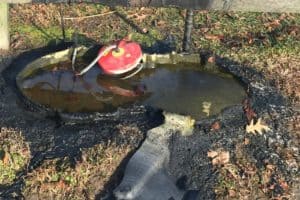Hay. Grain. Concentrate, sweet, and other prepared feeds. Bran. Oils. Vitamins and minerals. Supplements. Keeping up with the array of rations you can feed your horse can make your head spin. Indeed, nutrition is a complicated subject.
But our sources say that by monitoring just three things, you can keep most horses in top condition throughout the cold winter months. Those three simple things? Feed type, water, and body condition score.
The feed your horse consumes supplies the calories he needs to maintain good body condition. Adequate water intake encourages feed consumption and digestion and helps prevent dehydration and impaction colic. And your horse’s body condition score (which you can learn more about at TheHorse.com/30154) provides a measure of whether he’s getting enough nutrients to stay warm and nourished through the winter.
Read on to learn what our sources, who have encountered their fair share of cold weather, have to say about these three nutrition musts, plus a few bonus tips for your horse’s winter well-being.
Feed
Hay
Krishona Martinson, PhD, says one of the most common questions she and her colleagues get in the University of Minnesota’s Department of Animal Science is “How do I keep horses warm during winter?”
“I think a huge misconception is that grain keeps horses warm,” she says, “but actually, forage keeps horses warmer compared to grain. Forages, when fermented during digestion, produce calories plus heat that warms horses from the inside out. Grains go through a different digestive process and don’t produce as much heat.”
Martinson warns against changing feeding and management strategies quickly before a cold snap, though. “That’s where we see an increase in colic and other issues,” she says. “But gradually adding a few more pounds of hay during cold stretches would be an appropriate management step.”
The generally accepted food intake for the average (1,000-pound) horse is 2-2.5% of his body weight, or 20-25 pounds of feed per day, including forage and grain. But obviously the feed’s quality and energy density—which aren’t apparent without a forage analysis to determine digestible energy (DE)—play into that amount, as do the horse’s activity level and metabolism.
Another factor that affects that amount is the lower critical temperature (LCT), which varies by horse according to the temperature range he’s accustomed to, the length and thickness of his hair coat, the amount of body fat he has, whether he’s blanketed, and to what kind of shelter he has access. A horse’s LCT is the temperature at which he needs additional feed to maintain his core body temperature and can range from less than 20 to upward of 50 degrees Fahrenheit.
“If a horse is shivering, if his hair is standing on end (called piloerection) instead of lying flat, or if he’s seeking shelter from wind or precipitation, it’s likely that his LCT has been reached,” says Carey A. Williams, PhD, associate extension specialist at Rutgers University’s Department of Animal Sciences, in New Brunswick, New Jersey. “For each degree Fahrenheit the air is below the horse’s LCT, the caloric needs will generally increase by about 1%. It’s estimated that the average horse will need about 25% higher energy intake during the coldest winter months.”
“Below LCT, if the horse doesn’t have additional calories in the form of hay, he might start losing body weight,” says Martinson. “If your horse is plump, that’s not an issue in the short term, but if your horse is thin to start with or if you want to maintain body weight over an entire four- or five-month period, that could become a major health issue pretty quickly.
“If you’re feeding lower-quality hay and you notice that your horse is losing body weight or body condition score, gradually transitioning that horse onto a higher-quality hay may be all you need to do to get him back up to an acceptable range,” she continues. “The most important thing, if a horse owner is struggling with a horse’s body condition score, is that they first have their hay tested and then work with an equine nutritionist to fill in the gaps. Some universities have faculty that specialize in equine nutrition, and most equine feed companies have one or more equine nutritionists on staff. If you’re feeding a specific brand of feed, calling the number listed on the feed bag is the best place to start.”
Yet another factor you must “weigh” when deciding how much to feed your horse is the amount that’s wasted. Robert Coleman, PhD, associate professor and equine extension specialist at the University of Kentucky, in Lexington, recommends applying a 15-20% waste factor to the amount you feed. “If you’re feeding large round bales without a feeder, your waste can be as high as 57%,” he says.
Grain
Martinson says the vast majority of horses should get at least 75% of their energy from forage, whether hay or pasture, and the rest can be supplemented with a grain product or with a ration balancer, which is a condensed vitamin and mineral supplement fed daily in small amounts to fill nutrient gaps.
If you decide to add grain to your horse’s ration, Coleman recommends choosing one that’s processed to increase nutrient availability. “Corn will benefit from processing—steam-flaking being preferred over cracking,” he says. “Oats can be fed whole, as the starch is easily digested. Barley can be used, but should also be steam-flaked to aid in starch digestion. And, when adding grain, be sure to gradually increase the ration over three to four weeks to ensure the horse adapts slowly.”
Supplements
Your horse’s activity level and health needs might lead you to feed supplements in addition to his regular ration. “Management and feeding alterations may dictate the need for supplements that wouldn’t be required in summer months,” says Williams. “Supplementing a poor-quality hay diet with a multivitamin/mineral supplement specifically formulated for horses is a good idea during the winter months. However, there are no specific ‘winter supplement’ requirements, and products that claim such benefits are usually overpriced and not necessary. Be sure to carefully evaluate the label claims and avoid products that do not give a complete and specific list of ingredients.”
Williams adds that confining horses to stalls for long periods due to inclement weather imposes stress that might compromise immunity. Horses might find relief in immune-boosting supplements such as vitamin E (around 1,000 mg per day) and vitamin C (0.01 gram per kilogram body weight, twice a day). And, she says, if horses are cold-stressed, adding higher-calorie supplements such as grain-based concentrates or high-fat supplements such as rice bran or edible oils might be warranted.

Water
It’s vital that horses continue consuming sufficient water in winter. “Reduced water intake reduces feed intake, which reduces energy intake,” says Coleman.
In warm weather pastured horses eat more—and substantially wetter—grass than hay. So, in winter, if their forage changes to hay, they’ll need to drink more water to digest it effectively.
Horses are known to avoid ice-cold water, so heating your horse’s water will make it more palatable. “Use a water source that can be warmed to about 40 degrees Fahrenheit, or 4 degrees Celsius, and check that the water doesn’t become too warm, which can also reduce intake,” says Coleman. He also advises checking to be sure the electrical service is well-grounded so no stray voltage zaps your horse. And, he warns that heated water buckets can be fire hazards.
“We know that horses will maximize their water consumption when the water temperature is between 45 and 65 degrees Fahrenheit, so if you have a very cold, below-zero day, it’s going to take some effort to keep the water from freezing and to maintain it right around that 45-degree temperature,” says Martinson. “If you have automatic waterers, ensuring that they’re well-insulated and maybe in a sheltered area can help conserve heat. If you have a stock tank, you can try putting in one or more tank heaters. Here in Minnesota, a lot of people with the large 100-gallon tank heaters will insulate and cover half of the tank to help contain some of that heat.”
Because horses also aren’t going to want to touch an ice-cold salt block, you can encourage drinking by sprinkling table salt over their feed instead.
Another method of increasing water consumption is soaking pelleted or extruded concentrates, beet pulp, or hay cubes before feeding. Coleman says as long as you’re sure the feed will be eaten before it freezes, this method can be effective.
The biggest myth he encounters is that horses can get their water requirements from eating snow. “This isn’t a good plan for keeping horses,” he says.
Body Condition Score
Your best indicator of whether your horse is getting enough nutrition to maintain adequate body weight over the winter is his body condition score. Although this might be easy to judge visually when your horse has a slick summer hair coat, a shaggy winter coat will probably require hands-on assessment.

“The horse’s body condition going into winter is critical,” says Coleman. “A horse with a body condition score of 6.5 will have some added insulation that will help maintain core body temperature, while a horse with a BCS of less than 4 will have less insulation and require more energy. For a horse living outside in my area, my preference is 5-6.5.”
Take-Home Message
Your horse’s ability to maintain his weight and health over winter depends on factors such as his activity level, the region and climate, his metabolism rate, and feed quality. By tending to his feed and water needs and monitoring his body condition, you can ensure he enters spring as robust and healthy as he was when last year’s warm weather departed.


















